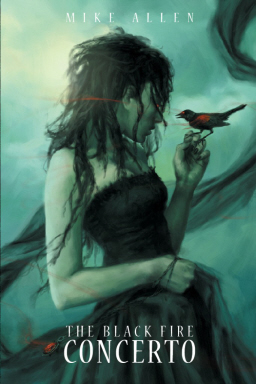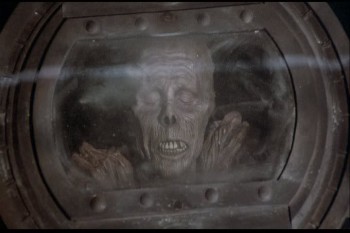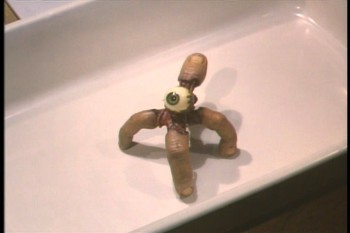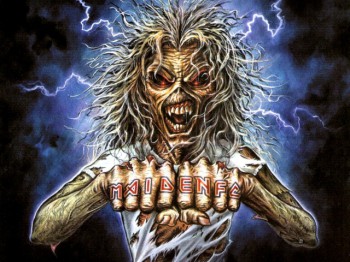The Black Fire Concerto & the Monsters of Memory
 I love monsters. Don’t we all?
I love monsters. Don’t we all?
When it comes to monsters, one of the best things about writing dark fantasy fiction is that it gives you a chance to build your own.
My first novel, The Black Fire Concerto, is packed with monsters. Black Gate overlord John O’Neill has generously invited me to talk about where my creatures came from, in the spirit of the Monstrous Posts on Monsters series I wrote many moons ago for all you denizens of the shadowlands.
The world of The Black Fire Concerto has been ravaged by a ghoul plague (though one could argue that’s the least of its problems.)
My ghouls are yet another riff on the zombie motif (now, now, no need to roll your eyes, just hear me out.) Most zombie plagues in film and in books pay a lip service of sorts to science fiction – the agent that gets dead flesh moving again is a virus, or an alien undeath ray, or something cut from that pseudo-scientific cloth.
Zombie epidemics have become so pervasive in popular culture, at least here in the U.S., that we only need a little hand-waving in the direction of chemical weapons and government conspiracies to suspend our disbelief – never mind that basic biology tells us the concept is ridiculous.

I took a simple step in a different direction. My ghouls are animated by magic. Just as with any classic zombie flick, bites spread the curse, but you can shoot a ghoul in the head a dozen times and it will still keep coming. Cut them up and they might have a harder time hurting you, but they’ll still try.
Theoretically, I suppose, they could rot to the point where it becomes too difficult to move. But fire is the only thing sure to disrupt the energies binding them – though to a lesser degree, cooking also does the trick, heh, heh.
When it comes to dreaming up monsters, I’m totally a child of the ’80s. The first zombie flick I ever watched was Dan O’Bannon’s Return of the Living Dead, the unofficial horror-comedy sequel to Romero’s Night of the Living Dead. What everyone remembers about that 1985 schlock-fest is that the zombies craved brains – eating grey matter dulled the pain of being dead.
What’s less remembered is that shooting a RotLD zombie didn’t phase them. Nothing short of incineration worked. When it comes to zombies, I’m definitely a student of the O’Bannon school.

Later in the story, my heroines Erzelle and Olyssa encounter creatures made out of still-moving ghoul parts. Some are small as insects, some are large as passenger jets.
Does anybody remember Stuart Gordon’s Re-Animator, the ultra-gory yet comic take on H.P. Lovecraft’s Herbert West sequence? 1985 was definitely a year for tongue-in-cheek bloodbaths and walking corpse comedy, wasn’t it?
If you’ve seen the film, then you certainly remember Dr. West musing, “Parts… I’ve never tried whole… parts.”
The film’s little seen 1989 sequel, Brian Yuzna’s Bride of Re-Animator, is utterly inferior in every respect but one. The unnerving, hilarious and at times oddly cute creatures made from the severed pieces of the re-animated. I couldn’t resist running with this deliciously rotten concept as far as it could go.
And later yet, we meet a character that to my mind evokes an ’80s horror icon from a different arena – the realm of heavy metal. Specifically, Eddie the ‘Ead, the very dead yet still quite lively mascot that appears on all of British band Iron Maiden’s album covers.

Though to be frank, a more appropriate model could be his counterpart Edwina, the mascot for the all-woman tribute band The Iron Maidens. (John O’Neill has also asked me for a post about the music that inspired The Black Fire Concerto, so perhaps we’ll come back to Iron Maiden then.)
The grotesquely desiccated space vampires from Tobe Hooper’s Lifeforce (1985 again, what a year!) would also fit the bill, yes, indeedy.
Of course, horror is full of human monsters, too. Cannibal families came to prominence in The Texas Chainsaw Massacre, which I first saw in the 1980s, surprise, surprise. Cannibalism tales have been taken to baroque heights by stories like Joe Hill’s “Best New Horror” Joe R. Landsdale’s “Incident On and Off a Mountain Road” and the wonderfully bizarre post-apocalyptic film by Jean-Pierre Jeunet and Marc Caro, Delicatessen.
Perhaps the latter has the most resemblance to my own dark take, though as with all the previous creatures I’ve discussed, I don’t play anything for laughs. I wanted to offer a different take on the “cannibal family,” a Branch Davidian take on Lovecraft’s deranged cultists. And I want my Family to be even worse than the ghouls, inverting the predator-prey relationship that’s at the heart of all those zombie stories.
Nightmares played a role here, too. The entire situation inside the riverboat fortress known as The Red Empress evolved from a bad dream of cannibalizing the undead that a friend shared with me years ago. The black robed Chef that oversees the sacrificial meals comes from a nightmare of my own, a dream I had as a teenager (oh those blood-soaked ’80s) that’s so vivid I remember it as if it really happened.
I’ve often mined my own nightmares for monsters. It’s a great source, don’t you think?
[…] first post about my novel The Black Fire Concerto discussed the monsters. (It’s only fitting, I think, […]
[…] to plug the book a couple times more at his other publishing venture, Black Gate. In “The Black Fire Concerto & the Monsters of Memory” I talk about my inspirations for the multitudes of undead ghoulies that populate the book. […]